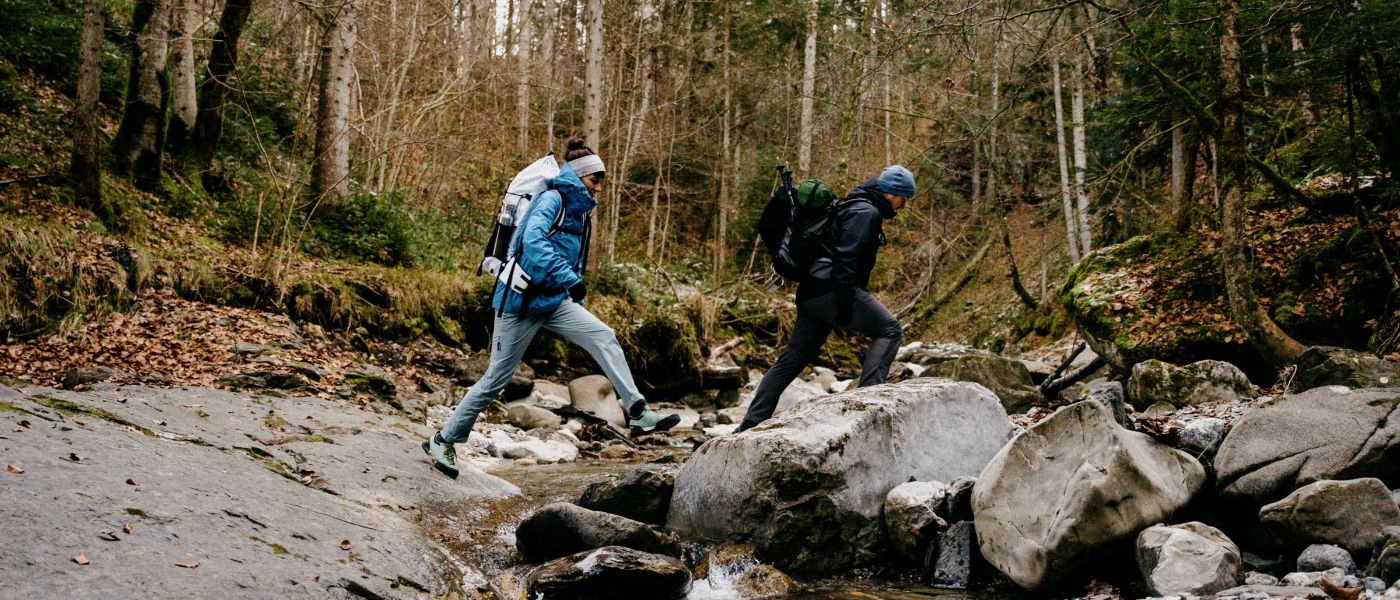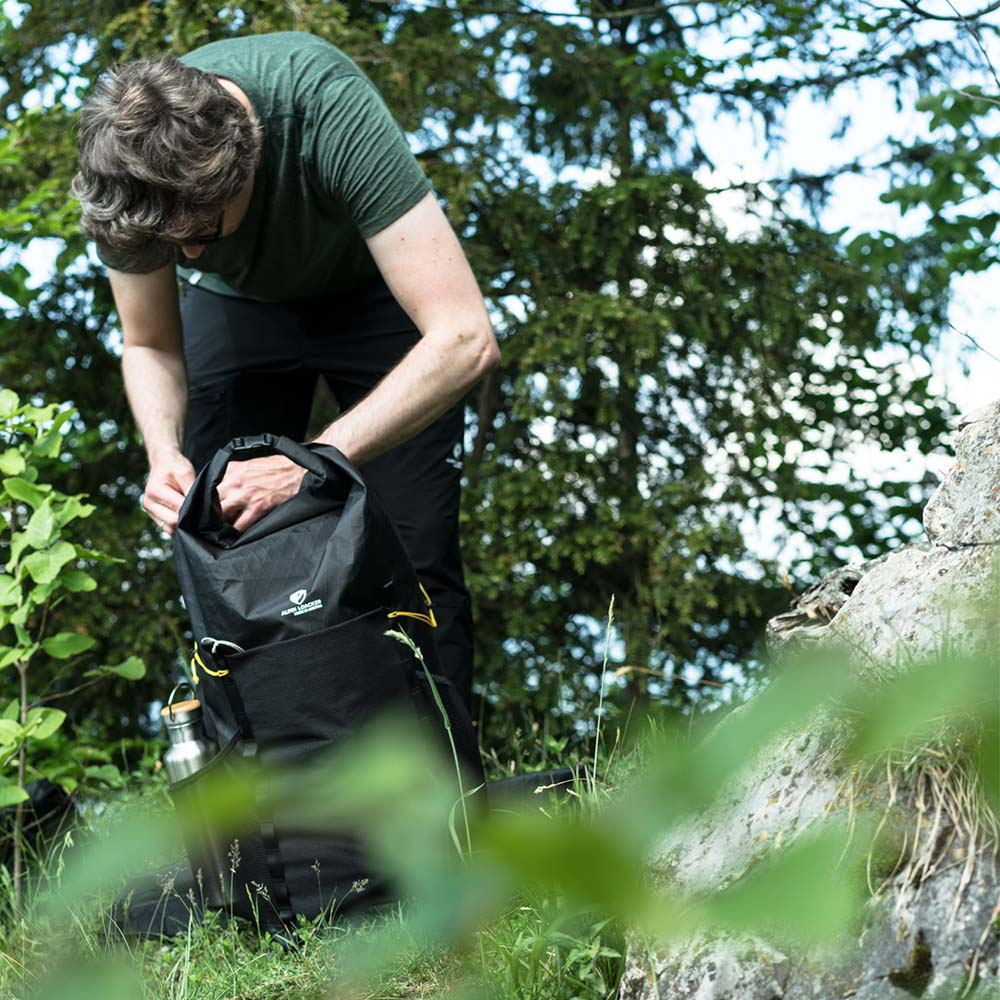Occasionally, even a rucksack needs cleaning. Either because it is dirty or smells bad. With the right backpack care, your backpack will last longer and protect the contents as it did on the first day of use.
Important: NEVER(!) wash the backpack in the washing machine - not even on delicate wash or hand wash programs!
If the backpack is slightly soiled:
- Larger soiling on the outside can be removed with a brush. Treat stains with a damp cloth or sponge.
- Turn the backpack inside out so that the inner side is now on the outside.
- Shake well so that loose dirt such as dust and grime fly off.
- Wipe off rough spots with a damp cloth or sponge.
- Hang the rucksack in a warm place and leave to dry completely.
If the rucksack is very dirty:
- Rinse the upturned rucksack in a bath or shower. If you have a bathtub, you can also "bathe" the backpack in it. You can also use a gentle detergent.
- Gently clean the dirty areas with a sponge or cloth.
- Rinse thoroughly with water. Squeeze out the padding such as the hip belt and shoulder straps and remove the detergent.
- Hang the rucksack in an airy, warm place out of direct sunlight and allow it to dry completely before stowing it away again.

Hang the opened backpack in a place where it can dry thoroughly.
Last but not least: never store your rucksack damp! It's best to leave it upside down to dry and check with your hands to see if there are any damp spots.
Related blog posts

Waterproof backpacks - definition and guide to waterproof hiking backpacks
Do I need a waterproof backpack for the mountains? We track down this question in the following blog post. We also bring light into the dark by dealing with the terms waterproof, waterproof and water -repellent and illuminating the differences. Are you ready?
Definition of waterproof, waterproof and water -repellent
Sometimes the information for clothing and outdoor equipment such as
- waterproof,
- water resistant
- And be quite confusing water -repellent, right?

Many people are therefore wondering which water column offers the optimal protection and the penetration of humidity can prevent. Who wants to be in the rain in the truest sense of the word?
What does waterproof mean?
The name waterproof is used for materials and clothing that offer optimal protection against moisture. They are often equipped with a membrane that successfully prevents water from penetrating. Even if you are traveling in the rain for a long time, the moisture stays outside.
Expert tip: If a backpack or clothing is described as waterproof, it must keep wet to 100 % to keep away from the inside of the backpack.
When is a backpack waterproof?
There are different classes. They are divided as follows: According to the European standard EN 343, a product with a water column from 800 mm is "waterproof (class 1 & 2)". From a water column of 1300 mm, it is considered "waterproof (class 3)", from 2000 mm "waterproof (class 4)".
What does waterproof mean?
Waterproof material, compared to waterproof fabrics, allows water - but the moisture can only penetrate after a certain time!
When is a backpack waterproof?
Waterproof, more precisely, water-resistant is a backpack if it can hold wetness, but cannot be ruled out that it will penetrate at some point. However, waterproof backpacks should normally keep the water away from the inside of the backpack for a few hours.
What does water -repellent mean?
Materials that emit the water are considered water-repellent so that it cannot penetrate. These materials usually have a special coating. The membrane ensures not to leave any wet inwards. The terms "waterproof" and "water -repellent" are often used synonymously. However, water-repellent materials are less robust than waterproof materials.
When do I need a waterproof backpack?
You should use a waterproof backpack for the following outdoor activities:
Climb: Waterproof backpacks for climbing are extremely resistant because they have to withstand the rock as long as possible. They are mainly made from truck-like tarpaulins such as TPU or similarly robust fabrics.
Biking: Most backpacks and bicycle bags are now completely waterproof. Here not only wetness from above and from the side, but also dirt and mud from the floor.
fishing: The use of a so -called so -called drybags. The waterproof pack sack is stowed in the backpack and offers perfect protection for all electronic objects.
Canoeing: A waterproof backpack is essential when canoeing. Ideally, this is combined with a drybag. So you are washed with all water.
Hike: You should not only be prepared on several days of hikes at any time. The weather can also change unexpectedly on day tours. A backpack with an integrated rain cover is therefore the ideal companion for all hiking friends.
If necessary, this can easily be put over the backpack and thus protect your equipment from moisture.
With these two aids you can make a backpack waterproof
- Waterproof or waterproof materials, if they do not consist of 100 % waterproof material, are often made waterproof by impregnation.

- Take aRain cover for the backpack if you cannot be sure regarding the weather course. Rain covers for hiking backpacks are available in different sizes. Occasionally, a rain cover is already installed in the backpack. Then this is often in the lower part - in the bottom of the backpack.

Conclusion
Whether you need a waterproof backpack always depends on your area of application. If you like to spend a lot of time outdoors and do not shy "bad" weather, you are well advised with one waterproof backpack.
In order to optimally protect your cell phone and the like, we recommend the additional use of a drypack if you stay out and outdoors outdoors. In size L this weighs just 25 g and guarantees you 100 percent waterproofness.
FAQ
What does not mean waterproof in shoes?
If shoes are declared as a not waterproof, they do not offer you wet protection. If you run over a wet meadow with these models, your feet are guaranteed to be wet. Incidentally, this also applies to tours in rainy weather.
Is weatherproof also waterproof?
The term "weatherproof" is mainly used for garden furniture. But you probably know the saying: "There is no bad weather, just bad clothes." The vernacular refers to waterproof tissue, which is colloquially referred to as "weatherproof". However, the correct name was "waterproof."
Would you like to know more about hiking backpacks?







